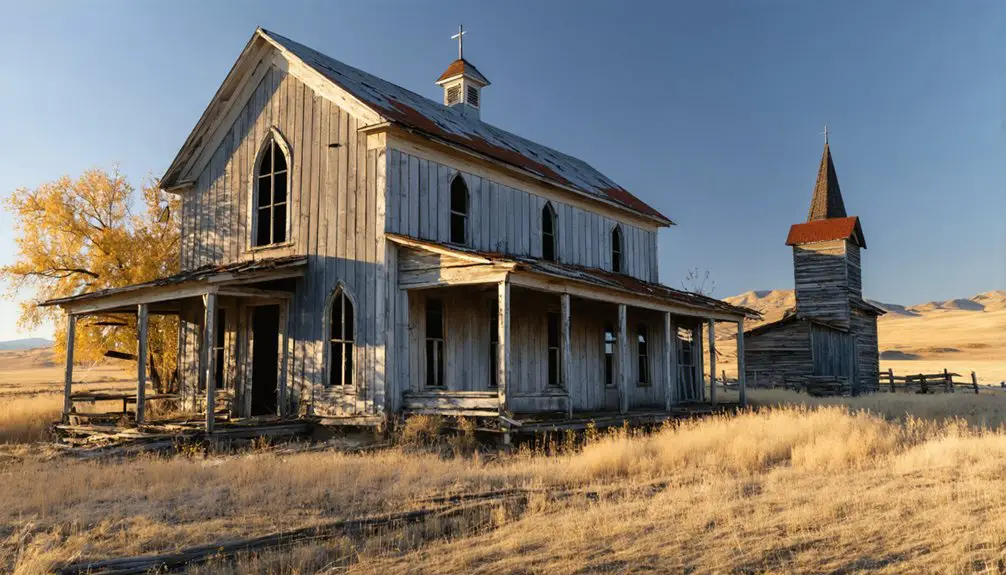You’ll find Princeton Ghost Town in Montana’s Boulder Creek District, where Dick Prince’s 1868 silver discovery sparked a thriving frontier settlement. The camp grew to include 20 wooden homes, a school, hotel, and Fraternity Hall, supporting about 50 miners who helped make Montana the nation’s second-largest silver producer. While the site produced $1.25 million in minerals, economic shifts and legal battles led to its decline. Today’s remote location offers a window into Montana’s rich mining heritage.
Key Takeaways
- Princeton Ghost Town sits 16 miles northeast of Phillipsburg, Montana, in the Boulder Creek District, discovered after Dick Prince found minerals in 1868.
- The town flourished during the 1880s silver boom with 50 miners, 20 wooden homes, and community buildings including a school and hotel.
- Total mineral production reached $1.25 million during peak operations, making Montana the nation’s second-largest silver producer.
- The site’s decline resulted from legal battles, declining ore values, and World War II regulations, leading to eventual abandonment.
- Visitors should bring supplies, use high-clearance vehicles, and respect private property when exploring the remote ghost town site.
Discovery and Early Mining Days
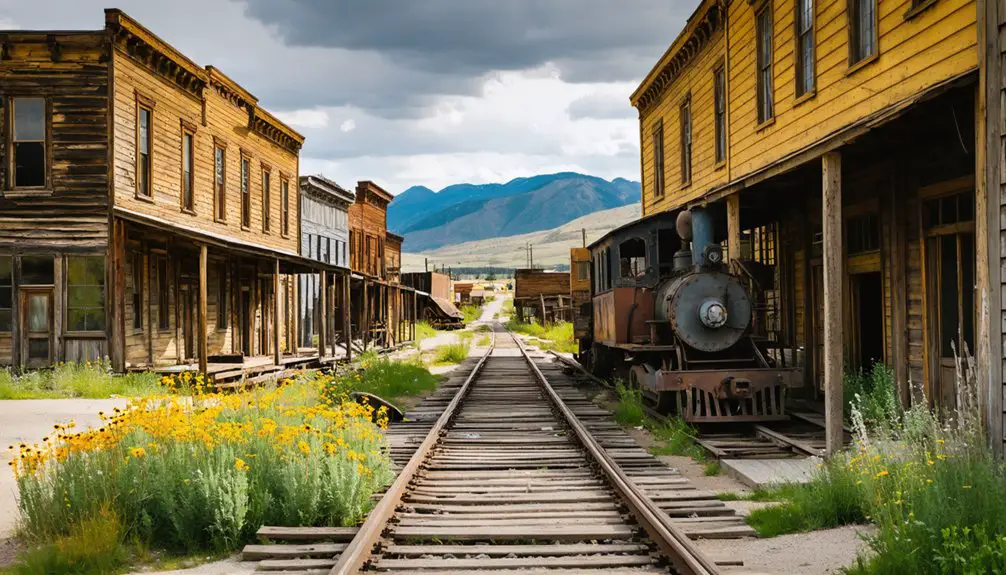
When Dick Prince stumbled upon rich mineral deposits at the junction of Princeton Gulch and Boulder Creek Canyon in 1868, he couldn’t have known his discovery would spawn one of Montana’s notable silver mining settlements.
You’ll find that early prospecting in the area began with small-scale claims, as rugged pioneers tested their luck in the Boulder Creek District‘s mineral-rich terrain.
While silver proved to be the primary draw, prospectors didn’t limit themselves to just one mineral. Like many of Montana’s millions in precious ores, the region’s wealth attracted waves of eager miners.
Though silver dominated the mining landscape, enterprising prospectors cast their nets wide in search of mineral wealth.
Mining techniques started simply, with individual claims dotting the landscape. As word spread of the area’s potential, more fortune seekers ventured into this remote corner of Montana.
The site’s strategic location, nestled at the convergence of two waterways, made it an ideal spot for what would soon become a bustling mining camp.
Life in the Mining Camp
If you’d visited Princeton in the 1880s, you’d have found around 50 workers rising early each morning to tackle grueling shifts in the silver mines while their families maintained the camp’s 20 simple wooden homes.
You’d have witnessed miners returning from their dangerous underground work to gather at the hotel, one of the few social spaces where the isolated community could find respite and connection at the miners’ picnic ground, which became a cherished spot for community gatherings and drilling competitions.
The presence of a school, post office, and general store helped establish a sense of permanence in this remote Montana settlement, where residents faced harsh mountain winters and limited amenities typical of frontier mining camps.
Daily Routines and Work
As dawn broke over the rugged Montana terrain, Princeton’s miners would begin their grueling workday at the silver mines that dotted Boulder Creek District.
You’d find yourself working alongside 50 other men, using rudimentary mining techniques while battling harsh conditions and limited worker safety measures. Much like the miners documented in Norman D. Weis’s extensive research on Northwestern mining communities, these workers faced daily dangers underground.
The daily grind involved:
- Excavating ore through underground tunnels using hand tools and explosives
- Sorting valuable minerals from waste rock at the surface
- Transporting heavy loads to the local mill for processing
- Maintaining essential equipment and tunnel supports
You’d spend long hours in physically demanding conditions, earning your wages through backbreaking labor.
When your shift ended, you’d head to your simple wooden dwelling or the company store, where basic supplies and preserved foods sustained you through another day in Princeton’s unforgiving landscape.
Community and Social Activities
Despite the harsh realities of mining life, Princeton’s social fabric thrived through its network of communal gathering spots. You’d find residents congregating at the town’s hotel, post office, and general store, sharing news and strengthening community bonds.
Similar to Fort Maginnis’ telegraph system, Princeton maintained vital communication links to other nearby settlements, helping residents stay connected to the outside world.
The local saloon served as a primary venue for social gatherings, where you could unwind with fellow miners over drinks, card games, and occasional live music.
The school became a cornerstone of community activities, hosting events that brought families together, while the hardware store and blacksmith shop doubled as informal meeting places where you’d catch up on local happenings.
Though smaller than neighboring boomtowns like Highland City, Princeton’s roughly 20 homes and essential facilities created an environment where social connections flourished despite the isolated mountain setting.
Silver Boom and Economic Growth
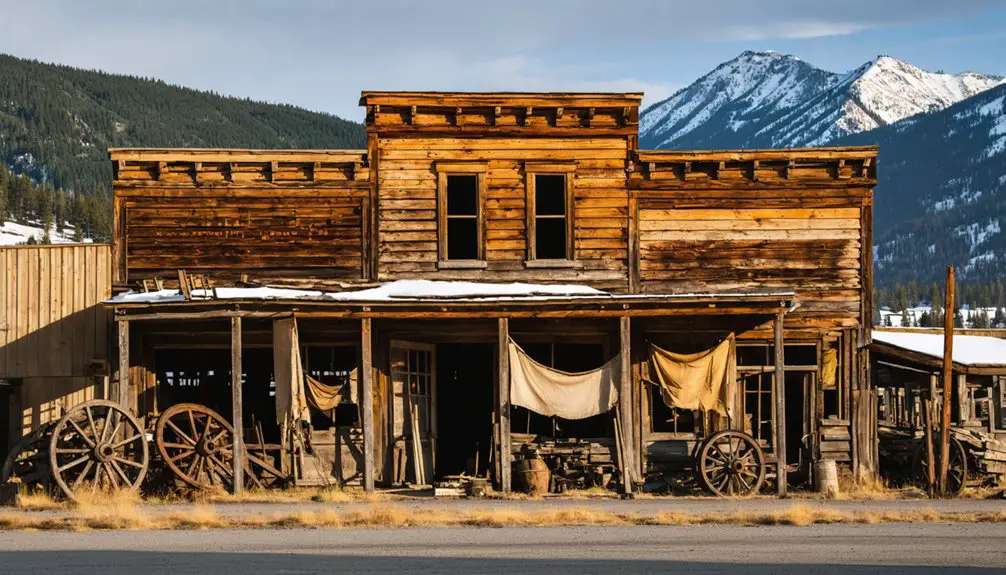
The lucrative silver boom of the late 1800s transformed Princeton from a modest mining camp into a bustling frontier settlement. The economic impact was significant as Montana became the nation’s second-largest silver producer, with the Philipsburg district contributing over 35% of the state’s output.
Princeton’s boomtown dynamics accelerated when the Princeton Mining Company began operations in 1882. Mining operations thrived as ascending hot waters created rich silver deposits in chemically favorable zones.
During the peak of silver production, you’d have witnessed:
- Employment of 50 miners extracting valuable ore deposits
- Total mineral production valued at $1.25 million
- Development of essential town infrastructure including a post office and hotel
- Profitable operations boosted by the Sherman Silver Purchase Act of 1890
The prosperity lasted until the silver market crashed due to overproduction, leading to Princeton’s eventual decline into a ghost town.
Geography and Natural Setting
You’ll find Princeton nestled at the junction of Princeton Gulch and Boulder Creek Canyon, approximately 16 miles northeast of Phillipsburg in Montana’s rugged Granite County terrain.
The ghost town‘s remote mountain setting, characterized by steep gulches and forested hillsides, played an important role in its mining history while presenting challenges for early settlers accessing the area. Much like how Princeton University’s campus spans over 600 acres of varied terrain, the Montana ghost town encompasses a significant area of mountainous landscape. The area’s wide open spaces and low population density create an atmosphere of profound isolation.
Today, you can reach the site by traveling north from Phillipsburg on Highway 10A to Maxville, then heading east on Maxville Road for about 6 miles through the mountainous landscape.
Mountain Landscape Features
Nestled within Montana’s rugged Rocky Mountains, Princeton ghost town occupies a dramatic setting at the convergence of Princeton Gulch and Boulder Creek Canyon, approximately 8.5 miles northeast of Phillipsburg.
The mountain ecology surrounding this remote site features steep terrain shaped by ancient glaciers, with dense conifer forests clinging to the rocky slopes.
The area’s distinctive geological formations showcase:
- Rich mineral lodes containing silver, gold, and lead deposits
- Complex quartz veins threading through metamorphic bedrock
- Abundant placer deposits in creek beds and gulches
- Ore-bearing rock formations typical of northern Rockies mining districts
You’ll find the landscape carved by seasonal mountain streams, which once powered mining operations and continue to shape the narrow canyons through annual freeze-thaw cycles and spring runoff.
Access and Road Conditions
While modern travelers can reach Princeton ghost town via Montana Highway 10A, accessing this remote mining site requires careful planning and suitable vehicles.
You’ll head north on Highway 10A for about 10 miles to Maxville, then turn east on Maxville Road for another 6 miles to reach the site.
For road safety, you’ll want to take into account seasonal conditions that can dramatically affect accessibility. In winter, snow and ice make 4WD vehicles essential, while spring brings muddy challenges to the dirt and gravel segments.
The mountain terrain demands extra caution as you navigate narrow bridges and wildlife crossings.
You’ll find limited cell coverage and minimal infrastructure in this rugged landscape, so pack emergency supplies and reliable navigation tools.
Summer and early fall offer the most favorable driving conditions.
Mining Operations and Production
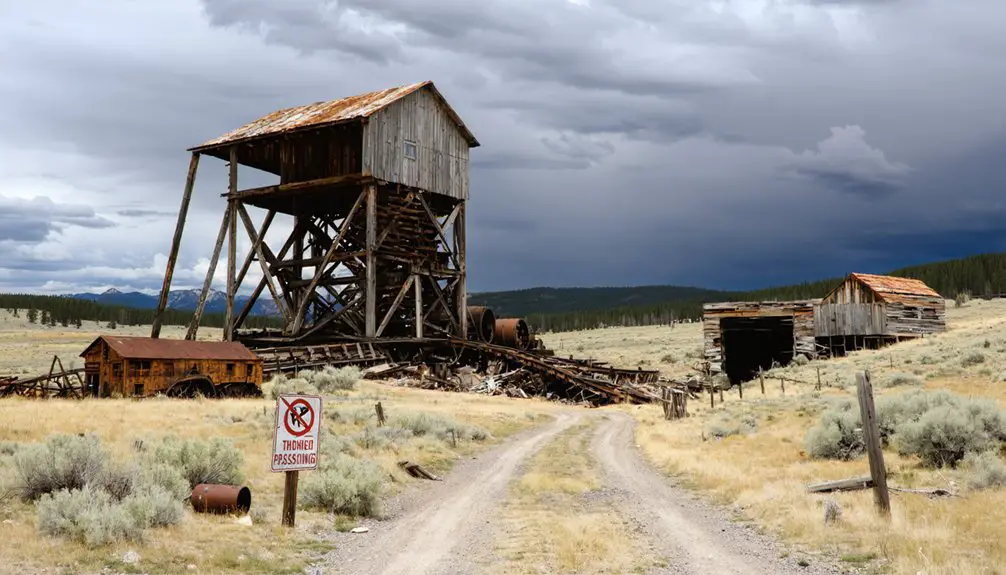
The Princeton Mine’s rich silver deposits fueled significant mineral production from 1868 to 1907, yielding approximately $1.25 million in combined metal value.
You’ll find that mining techniques primarily focused on underground ore extraction, with about 50 miners working the veins during peak operations in the 1880s.
The mine’s production prominently included:
- Silver as the primary commodity
- Supplemental gold deposits
- Lead ore extraction
- Phosphate mineral recovery
The Princeton Mining Company, headquartered in Missoula, transformed what began as a prospector’s discovery into a substantial operation.
They built processing facilities and a mill east of the main site to handle ore from multiple local mines.
While mining ceased in the early 1900s, the site’s contribution to Montana’s mining heritage remains significant.
Community Infrastructure and Services
You’ll find Princeton was more than just a mining operation, with essential services like a post office and general store supporting daily life for the camp’s residents and workers.
The town’s commitment to community development showed in its educational facilities, where a schoolhouse served the miners’ children, demonstrating that families were part of Princeton’s social fabric. Much like Comet City’s school which had twenty students enrolled, Princeton’s educational system helped foster a sense of community. Like many mining towns of the era, Princeton hosted lively gatherings at its Fraternity Hall where residents could socialize.
Local businesses, including a hotel and merchant establishments, kept the camp connected to regional supply networks while providing necessary goods and services to sustain the mining population through Montana’s challenging seasons.
Daily Life Support Systems
Life support systems in Princeton revolved around practical necessities that enabled miners and their families to survive in Montana’s rugged mountain terrain.
You’d find about 20 residential structures clustered near the mine, built from local timber and stone. Food supply came from a combination of the town store’s provisions and your own resourcefulness through hunting and gardening. During its peak, the town supported 500 frontier residents who relied on various community services.
Essential daily operations depended on:
- Water drawn from Boulder Creek Canyon and Princeton Gulch
- Wood fuel gathered from surrounding forests for heat and cooking
- Oil lamps and candles for lighting after dark
- Outhouses and waste pits for basic sanitation
You’d rely on dirt roads for transportation and would need to preserve food through salting and smoking, as there wasn’t any refrigeration.
The community’s survival often hinged on sharing resources and working together to overcome the harsh mountain conditions.
Education and Mail Services
While miners toiled at Princeton’s ore deposits, crucial community services took shape through the establishment of a post office and schoolhouse in the 1880s.
You’d find these essential institutions serving about 20 families near the company hotel, creating a small but vibrant community hub.
The education impact reached beyond basic reading and writing, as the schoolhouse symbolized stability in an otherwise transient mining camp.
Similarly, the mail significance can’t be understated – the post office kept Princeton’s residents connected to the outside world through crucial communication channels in Montana’s remote terrain.
Like many mining towns, Princeton’s services reflected the boom-bust cycle.
When mining declined after 1900, both the school and post office closed, leaving only remnants that you can still visit today.
Local Business Operations
Three key businesses anchored Princeton’s commercial heart in the 1880s: the company store, a modest hotel, and the bustling Princeton Mine operation.
You’ll find that local trade revolved around these establishments, with the store serving as the primary retail hub for the mining community.
The town’s retail history shows a practical approach to commerce, with essential services focused on mining operations:
- Mining supplies and tools for the 50+ workers
- Basic provisions and household necessities
- Lodging services for transient miners
- Mail and communication facilities
While you wouldn’t find luxury goods in Princeton’s store, the business operations supported a self-sufficient community of miners and their families.
The town’s commercial activity thrived until the early 1900s, when declining silver production led to the eventual closure of most local businesses.
Decline of the Mining Era
Although Princeton’s mining operations flourished in the 1880s under R.T. Bayliss, the mine’s prosperity wouldn’t last.
You’ll find that economic shifts began taking their toll as a devastating legal battle between Montana Mining Company and St. Louis Mining drained nearly $400,000 in litigation costs between 1889 and 1911. The Supreme Court’s ruling in favor of St. Louis Mining dealt a crushing blow to the operation’s viability.
Princeton’s mining legacy further dimmed when World War II brought strict regulations banning gold and silver mining as nonessential activities.
Even after the war, you couldn’t profit from mining with gold fixed at $35 per ounce while operational costs soared.
The town’s fate mirrored many Montana mining communities, as declining ore values and mounting expenses forced operations to cease, leaving behind empty buildings and fading dreams.
Present-Day Remnants

Despite decades of abandonment, Princeton’s ghost town retains several original structures that offer a compelling glimpse into Montana’s mining heritage.
You’ll find remarkably preserved dwellings with plaster-filled log walls and sections of original tin roofing, showcasing the area’s abandoned architecture. The historical preservation of these buildings remains largely untouched by vandalism, with some structures still serving as summer residences.
When exploring Princeton’s remnants, you’ll discover:
- An old mill site east of town, reflecting the area’s industrial past
- Original dwelling walls with intact plaster between logs
- Surviving tin roofs demonstrating period construction methods
- Building remnants revealing historic nail patterns and wood layering
You can access these historic ruins via Montana Highway 10A and Maxville Road, 16 miles northeast of Phillipsburg.
Historical Legacy and Impact
Princeton’s historical legacy began in 1868 when Dick Prince made the first mining discovery in Montana’s Boulder Creek District, setting off a chain of developments that would shape the region’s future.
Dick Prince’s 1868 discovery in Boulder Creek sparked a mining legacy that would forever change Montana’s landscape.
You’ll find Princeton’s impact woven into Montana’s mining fabric, contributing $1.25 million in precious metals that helped establish the territory’s economic foundation.
While mining technology evolved from simple prospecting to industrialized operations under the Princeton Mining Company, the town’s influence extended beyond mere mineral extraction.
You can trace Princeton’s role in Montana’s development through its transformation from a frontier outpost to a structured community with schools, homes, and social institutions.
Though less celebrated than some of Montana’s other mining towns, Princeton’s historical preservation efforts remind you of an era when independent prospectors and mining companies shaped Montana’s destiny.
Getting There and Site Access
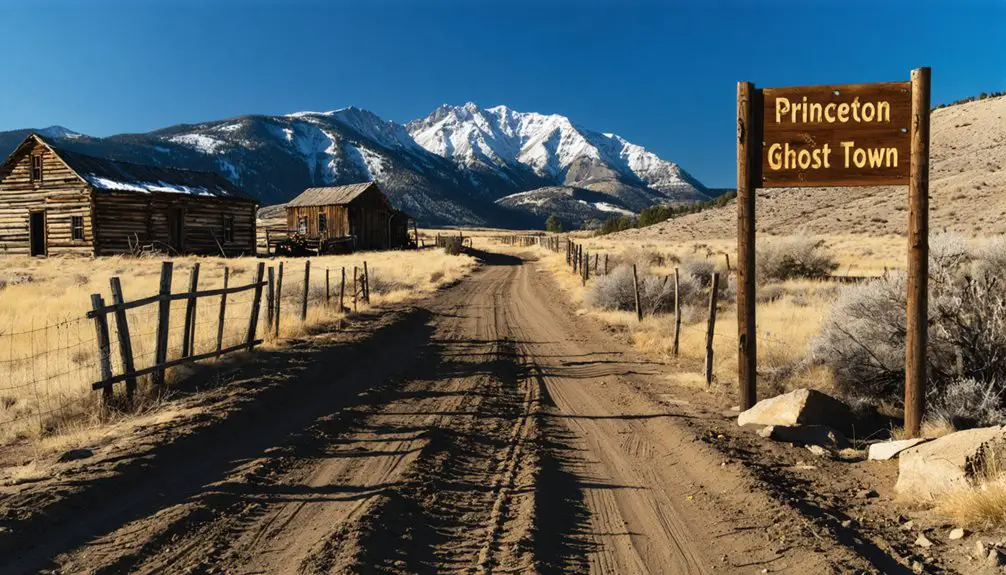
When planning your visit to Princeton ghost town, you’ll find the site nestled 16 miles northeast of Phillipsburg in Montana’s rugged Boulder Creek District.
Take Highway 10A north for 10 miles to Maxville, then head east on Maxville Road for 6 miles to reach the historic townsite.
For ideal visitor safety and navigation, remember these essentials:
- Drive a high-clearance vehicle, as road conditions beyond Maxville are mostly unpaved.
- Download offline maps since cell service is unreliable in the canyon.
- Bring necessary supplies, including water and food, as no facilities exist on-site.
- Respect private property, as some structures house summer residents.
The site’s remote location demands self-reliance, but rewards explorers with an authentic glimpse into Montana’s mining heritage.
Frequently Asked Questions
Are There Any Reported Ghost Sightings or Paranormal Activity in Princeton?
Dead as a doornail when it comes to ghostly encounters – you won’t find any documented paranormal activity or local legends here. Historical records and current resources don’t mention any supernatural happenings.
What Happened to the Original Mining Equipment and Machinery?
You’ll find Princeton’s mining legacy largely vanished – equipment was salvaged, sold for scrap, or abandoned to decay. No formal equipment restoration occurred, with machinery either repurposed at other mines or left to deteriorate naturally.
Who Owns the Remaining Buildings and Land in Princeton Today?
You’ll find today’s Princeton buildings and land are privately owned by summer residents, though specific current ownership details aren’t publicly documented and no known property disputes exist.
Were There Any Major Accidents or Disasters During the Mining Operations?
You’ll find records of mining accidents at Princeton from February 1917, though specific details are limited. The mine’s proximity to Butte’s copper operations suggests it faced similar disaster impact and hazards.
Did Any Notable Historical Figures Ever Visit or Live in Princeton?
Like shadows in time, you won’t find famous visitors or figures of historical significance here. Records don’t show any notable personalities ever calling Princeton home or stopping by during its mining days.
References
- https://www.legendsofamerica.com/princeton-montana/
- https://www.legendsofamerica.com/mt-ghosttowns/
- https://www.mountain-home.com/blog/vacation-planning/guide-montana’s-ghost-towns
- https://www.instagram.com/p/C9Kg6iVsYwg/
- https://www.youtube.com/watch?v=EPQMSa7BauM
- https://www.mtmemory.org/nodes/view/128340
- https://archiveswest.orbiscascade.org/ark:80444/xv647063
- https://freepages.history.rootsweb.com/~gtusa/usa/ca/mt-bullion.htm
- https://en.wikipedia.org/wiki/List_of_ghost_towns_in_Montana
- https://www.tiktok.com/@idea.soup/video/6842437553421946117
